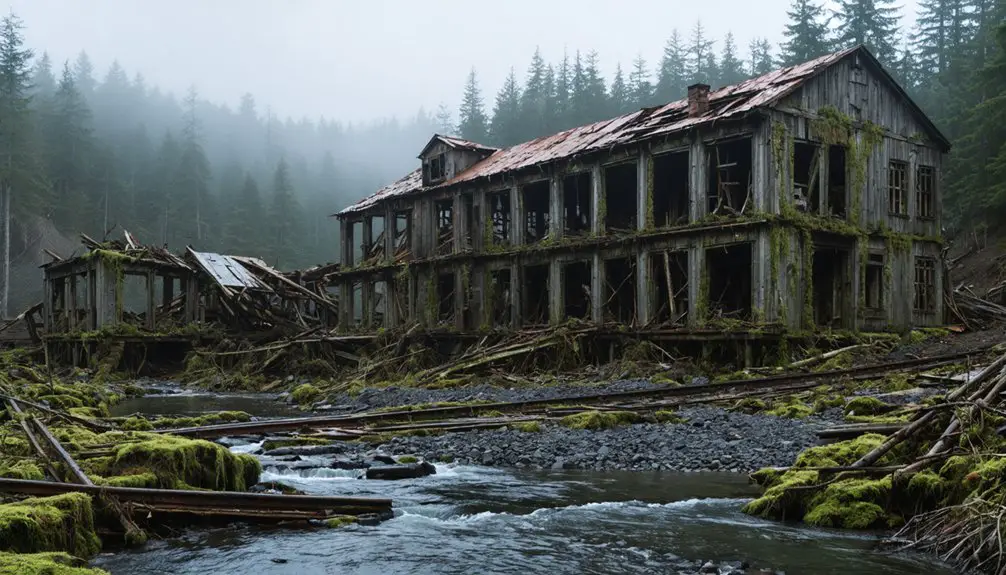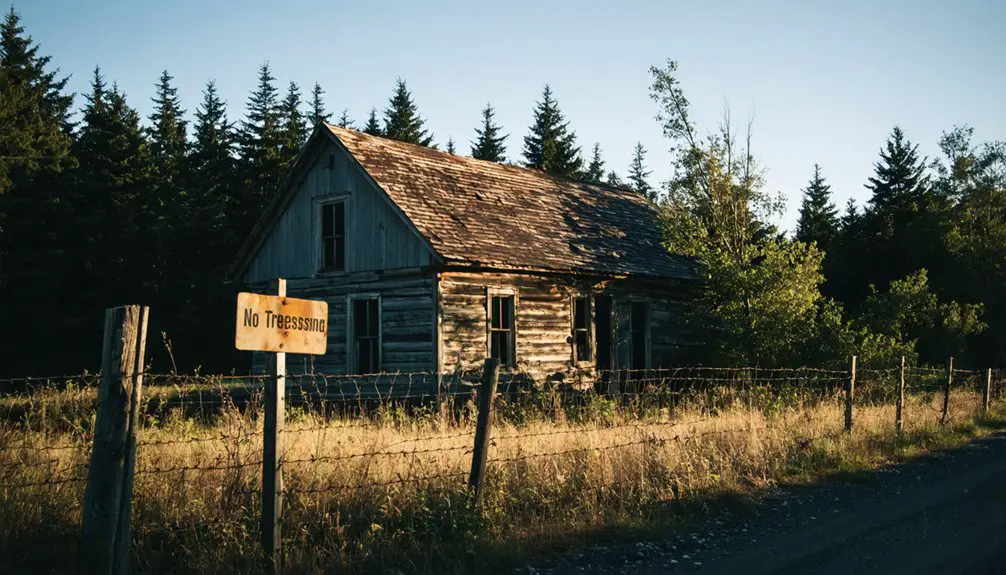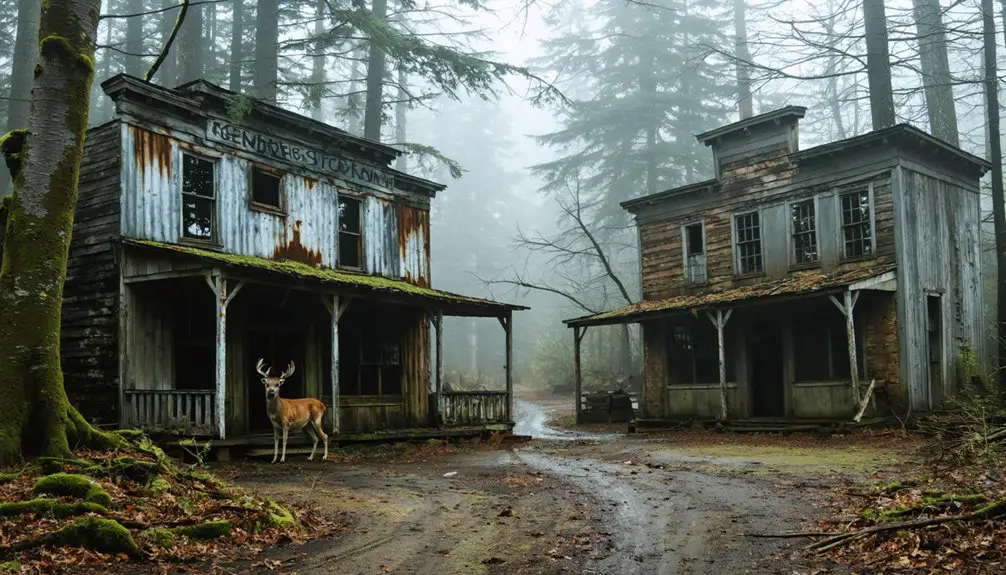You’ll find Nagrom’s ghostly remains in Washington state, where Elmer G. Morgan established a lumber town in the early 1900s by spelling his surname backward. The Northern Pacific Railway connected this once-bustling community to major markets, while the Morgan Lumber Company processed timber from surrounding old-growth forests. Today, Tacoma Public Utilities restricts access to the abandoned site, where nature has reclaimed the foundations of this fascinating piece of Pacific Northwest logging history.
Key Takeaways
- Nagrom was established in the early 1900s as a company town by Elmer G. Morgan, who named it by spelling his surname backward.
- The town centered around the Morgan Lumber Company and relied heavily on the Northern Pacific Railway for timber transportation.
- Once a thriving lumber community, Nagrom declined after the railroad line was mothballed in the 1980s.
- The abandoned town site is now owned by Tacoma Public Utilities and access is restricted for watershed protection.
- Nature has reclaimed most of the former logging town, with only structural foundations and artifacts remaining beneath vegetation.
The Birth of a Lumber Town
In the dense forests of western Washington’s Green River Valley, Nagrom emerged as a quintessential company town in the early 1900s.
You’ll find its origins tied directly to Elmer G. Morgan, who cleverly named the settlement by spelling his surname backward. As founder of the Morgan Lumber Company, he established the town’s core infrastructure around timber processing and worker housing.
The company strategically positioned Nagrom to capitalize on the surrounding old-growth forests, implementing logging techniques that would efficiently harvest and transport timber.
By 1911, an essential railroad branch connected the isolated community to regional markets, enabling the transport of raw logs and finished lumber products. The town quickly became a thriving logging community with a dedicated schoolhouse and other essential buildings.
The vital rail connection in 1911 transformed Nagrom from a remote logging outpost into a significant timber producer.
The town’s development reflected Morgan’s vision of a self-contained logging community, where every aspect of life centered around the lumber industry. Located within King County’s boundaries, Nagrom maintained its distinct identity as a specialized timber processing settlement.
Life in Early Nagrom
If you’d visited Nagrom during its heyday, you’d have found workers rising before dawn to tackle grueling shifts at the logging camps and railway yards.
Much like how salt was essential for settlers in early American settlements, lumber was a critical resource that drove Nagrom’s economy and daily life.
The town’s social fabric was woven through shared meals at company lodgings and informal gatherings where workers could briefly escape their demanding routines.
Despite the harsh conditions, residents fostered a tight-knit community through weekend baseball games, holiday celebrations, and impromptu musical evenings at workers’ homes.
Daily Worker Routines
Life in early Nagrom revolved around the demanding routines of lumber operations, where workers faced long days of physical labor from sunrise to sunset.
Worker schedules followed nature’s rhythm, with logging techniques adapted to seasonal conditions and daylight availability.
Like the train depot schedule at nearby Govan established by the Central Washington Railway, daily operations had to maintain strict timing.
Your typical day in Nagrom’s lumber operations would’ve included:
- Starting before dawn at the company housing, preparing for intense physical work
- Trekking to cutting sites with basic tools like axes and crosscut saws
- Coordinating with teams to fell, limb, and transport logs to the mill
- Operating or assisting with sawmill machinery until dusk
You’d need to stay alert despite exhaustion – the job’s dangers demanded constant vigilance.
The railroad’s schedule dictated much of your routine, as you helped load finished lumber and unload essential supplies to keep operations running smoothly.
Community Social Activities
Despite the exhausting demands of logging work, Nagrom’s residents built a vibrant social community through regular gatherings and shared activities.
Community bonding flourished during outdoor activities like hunting, fishing, and seasonal festivals tied to logging cycles. You’d find families gathering at community picnics, barbecues, and evening music sessions around campfires. Like in Lester, the residents hosted dances and movies for entertainment.
The general store served as a natural hub for socializing and sharing news, while the community hall hosted celebrations and events that strengthened social traditions.
When hardship struck, neighbors pulled together through mutual aid networks, sharing resources and labor.
Entertainment centered around simple pleasures – card games, storytelling, and informal sports matches.
Religious gatherings and traveling entertainers added variety to social life, while radio listening sessions brought the outside world into their tight-knit community.
Morgan Lumber Company’s Legacy
While many lumber companies have come and gone throughout the Pacific Northwest, Morgan Lumber Company’s legacy stands as a tribute to multi-generational success in the industry.
Similar to how the St. Paul & Tacoma Lumber Company operated continuously for seven decades through major challenges, Morgan’s resilience shaped their lasting impact.
You’ll find their lumber impact deeply rooted in technological innovation and family values that span four generations.
The Morgan legacy encompasses:
- A remarkable shift from a portable sawmill to a high-capacity production facility
- Integration of computerized technology and advanced dry kiln capabilities
- Commitment to premium southern yellow pine lumber production
- Dedication to environmentally responsible forestry practices
The company’s transformation under Billy Morgan’s leadership in the late 1950s set new standards for operational excellence.
The early building supply store helped diversify their operations beyond sawmills.
They’ve maintained their competitive edge through continuous modernization while preserving core values of integrity and trust that J.C. Morgan established in the 1940s.
Railroad’s Role in Town Development
You’ll find that Nagrom’s entire existence centered around the Northern Pacific Railway branch constructed in 1911, which transformed the area into a crucial transportation hub.
The railway’s presence enabled the efficient movement of timber products from Morgan Lumber Company’s operations, connecting the remote mountain town to major markets throughout King County. The Northern Pacific had already established its dominance in the region through federal land grants decades earlier. Like nearby Lester, the town relied heavily on its coal handling facilities, which processed tens of thousands of tons annually.
This essential shipping route proved indispensable for Nagrom’s growth and development until the 1980s, when Burlington Northern’s decision to mothball the line contributed directly to the town’s eventual abandonment.
Railroad Transportation Hub
Three key developments shaped Nagrom’s early growth as a railroad transportation hub when the Northern Pacific Railway constructed a branch line to the town in 1911.
The strategic location along the Green River Valley provided essential rail access that transformed the town’s economic viability. The establishment of this rail connection represented part of the crucial expansion period that characterized Washington State’s mid-to-late 19th century development.
You’ll find these critical elements defined Nagrom’s rail operations:
- Year-round shipping capabilities that enabled continuous timber transport and supply movement
- Direct connections to major markets including Puget Sound, facilitating broader trade reach
- Enhanced regional interdependence through links to neighboring towns like Lester
- Efficient loading infrastructure with docks and warehouses positioned along the tracks
The rail hub status attracted workers and businesses, while the Northern Pacific’s investment demonstrated strong confidence in the town’s long-term prospects.
Vital Lumber Shipping Route
As the Northern Pacific Railway expanded its operations in 1892, Nagrom emerged as an important lumber shipping hub that facilitated the transport of over 1.2 billion board feet of timber from Washington’s forests.
You’ll find that the town’s strategic position along the rail line made it vital for lumber logistics, with extensive facilities including roundhouses, machine shops, and coal docks supporting the bustling timber trade.
The partnership between lumber companies and the railroad shaped Nagrom’s development, as rail access spurred the establishment of mills and logging camps nearby.
You can trace how the Northern Pacific’s subsidiary lines connected remote timber stands to sawmills and major markets, particularly in the Midwest, while volume-based payment models guaranteed steady transport capacity despite market fluctuations.
The Green River Watershed Impact

While Nagrom’s abandonment markedly altered the local landscape, its lasting impact on the Green River watershed has proven far more significant.
You’ll find the region’s watershed conservation challenges stem from decades of environmental changes that continue to affect the Green River’s delicate ecosystem.
Key watershed impacts include:
- Reduced groundwater flows from increased pumping, stressing aquatic habitats
- Urban runoff carrying pollutants like mercury, copper, and PCBs into the river system
- Temperature and dissolved oxygen problems threatening salmon populations
- Loss of essential floodplain connectivity and woody debris vital for fish habitat
These changes have created a complex web of environmental challenges, particularly for salmon recovery efforts.
The watershed’s health directly influences local communities, making ongoing restoration efforts vital for the region’s ecological future.
Tacoma’s Water Rights and Town Decline
The transformation of Nagrom’s fate became inextricably linked to Tacoma’s aggressive expansion of water rights in the early 1900s. When Tacoma secured Green River as its primary water source in 1910, you could see the writing on the wall for small upstream communities like Nagrom.
The city’s $2.25 million pipeline project reflected urban priorities that would reshape the watershed’s future. As Tacoma’s infrastructure grew, including a 43-mile pipeline delivering 42 million gallons daily by 1913, Nagrom’s access to essential water resources diminished.
The town’s dependence on local water for both community life and logging operations couldn’t compete with Tacoma’s municipal power. Legal battles and landowner resistance along the pipeline route highlighted the tensions, but ultimately couldn’t prevent Nagrom’s decline as water rights shifted to serve the growing city.
Remnants and Restricted Access

Modern visitors seeking traces of Nagrom’s past will find nature has largely reclaimed the former logging town. The remnant discovery process is challenging, as dense forest growth obscures most structural foundations and industrial artifacts that once defined this bustling community.
Access challenges are significant since Tacoma Public Utilities owns and restricts entry to protect the Green River watershed. If you’re planning to explore, you’ll need to navigate:
- Controlled access points requiring proper authorization
- Unmaintained roads and decommissioned rail lines
- Natural hazards including unstable ground and hidden industrial remnants
- Wildlife presence and environmental protection measures
Your best option for studying Nagrom involves coordinating with authorities, as the site isn’t developed for heritage tourism. Most explorers opt for more accessible ghost towns with visible ruins and established trails.
Preserving Nagrom’s Memory
Preservation efforts keep Nagrom’s legacy alive through dedicated historical documentation and community engagement.
You’ll find local historians actively collecting oral histories, photographs, and artifacts that highlight the town’s cultural preservation while maintaining its historical significance in Washington’s logging and railroad heritage.
Through educational programs and interpretive materials, you can explore Nagrom’s story in regional museums and online platforms.
Former residents and their families participate in reunions and commemorative events, sharing personal accounts that enrich the historical record.
Social media groups serve as virtual gathering spaces where enthusiasts exchange photos and memories.
While physical access remains restricted, advocacy groups work with Tacoma Public Utilities to balance watershed protection with historical recognition through signage and markers in nearby communities.
Frequently Asked Questions
Are There Any Surviving Former Residents of Nagrom Still Alive Today?
You won’t find any surviving residents or personal stories from Nagrom today, as records show the last inhabitants left by the 1950s when Tacoma’s watershed restrictions forced everyone to relocate permanently.
What Was the Peak Population of Nagrom During Its Most Active Period?
You’ll find that Nagrom’s peak population reached about 450 residents during its most active years between 1911-1924, before its eventual population decline marked a significant turning point in the town’s history.
Were There Any Schools or Churches Established in Nagrom?
While records show larger ghost towns had schools and churches, you won’t find evidence of formal Nagrom education or religion facilities. The company town’s industrial focus likely didn’t support these community institutions.
What Happened to the Buildings and Equipment After the Town Was Abandoned?
You’ll find most equipment was removed when operations ceased, while abandoned structures gradually decayed under Tacoma’s watershed protection. The restricted access actually helped preserve some historical remnants from vandalism.
Did Any Other Industries Besides Logging Operate in Nagrom?
You won’t find evidence of farming practices or mining operations in Nagrom – logging was the town’s sole industry. The Morgan Lumber Company dominated all economic activity until the town’s eventual abandonment.
References
- https://www.loquis.com/en/loquis/6455686/Nagrom+Washington
- https://stateofwatourism.com/ghost-towns-of-washington-state/
- https://www.historylink.org/File/20841
- https://en.wikipedia.org/wiki/Nagrom
- https://www.instagram.com/p/DDio2lAMiFd/
- https://www.instagram.com/p/C1LSQUHPskI/
- https://www.genealogieonline.nl/en/over-de-plaats/5800795/lester
- https://www.johnhaycenter.org/index.php/our-history/local-history/washington-countys-1st-settlement
- https://ia801604.us.archive.org/8/items/historyofwashing00wash/historyofwashing00wash.pdf
- https://kingcounty.gov/vi-vn/-/media/king-county/depts/dnrp/building-property/historic-preservation-program/papers-and-research/kingcountyhistoricsettlementcontext.pdf



